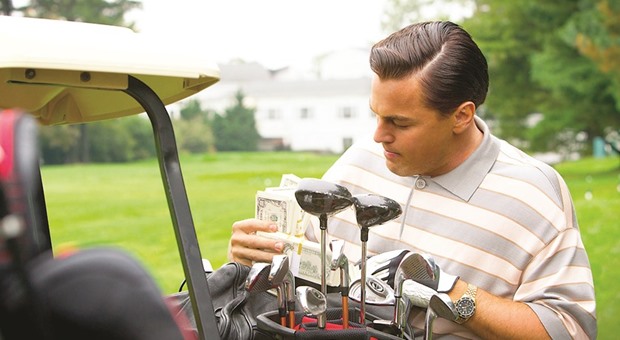Leonardo DiCaprio’s Titanic immortalised a scene that dozens of films since 1997 have been copying with gusto. Arms outstretched, DiCaprio stands with Kate Winslet, also with her arms stretched far, at the tip of the Titanic, their passionate love all set to be doomed on an icy night on the high seas.
Despite the 14 Academy nominations which Titanic clinched (garnered only by All About Eve in 1950) and the 11 Oscars it actually sailed along with on the big night in 1998 (only Ben-Hur in 1959 and The Lord of the Rings: The Return of the King in 2003 have equalled this), DiCaprio went home unsung for playing a poor boy on board that “unsinkable” ship who falls in love with a rich girl. The Best Actor Oscar went to Jack Nicholson in As Good As It Gets. DiCaprio was not even nominated that year!
DiCaprio, one of the finest actors with this rare ability to sink into the skin of a character, has received the nod for the Best Actor Oscar from the Academy of Motion Picture Arts and Sciences several times, the latest being for The Revenant this year.
The Revenant is a revenge drama directed by Alejandro Inarritu (who has given us gems like 21 Grams, Babel and Birdman), and tells the tragic tale of fur trapper Hugh Glass, who lived in Montana and South Dakota during the 1820s. As the protagonist, Glass, in the movie, DiCaprio is brilliant, playing a hunter who is left behind by his fellowmen thinking that he is dead.
Will DiCaprio, who has been gutsy to experiment with a variety of characters and has come out with flying colours, win the coveted trophy this year?
His chameleon-like ability has seen him essay widely different roles which certainly deserved an Oscar. Here is a look at the films where his nomination did not translate into an actual honour.
In the 2004 The Aviator, DiCaprio becomes Howard Hughes — that eccentric millionaire who turns into a crazy reclusive. DiCaprio’s own transformation was an example of sheer cinematic genius.
Two years later, DiCaprio became Danny Archer in Blood Diamond — a story woven around death and destruction during the 1999 civil war in Sierra Leone, where the precious stones were traded to fund brutal conflicts in Africa. Archer is a gunrunner, who despite all the gore around him, shines in a splendid portrayal of a man torn between emotion and avarice.
DiCaprio plays a US Marshal, Teddy Daniels, in Shutter Island (by Scorsese, 2010) — restrained, layered and with no trace of overt heroism.
As the highly mean and selfish businessman making money without morals in Wolf of Wall Street (2013), DiCaprio is Jordan Belfort. That sleazy, slimy character was a totally different avatar we saw of DiCaprio, whose extraordinary talent deserved an Oscar. But...
Will DiCaprio’s name pop out of the white envelope on that magical night at least this year on February 28?
* * *
Thaarai Thappattai
Bala’s Thaarai Thappattai is a powerful documentation of a folk form in Tamil Nadu that is performed by extremely agile women to the beat of several musical instruments, but chiefly a drum called thaarai thappattai. Narrated through a gripping plotline and embellished with some haunting Ilaiyaraaj music and almost acrobatic dances, the film is a tragic reminder of how ancient Indian traditions and arts are falling prey to modernism, struggling, in the bargain, to retain their purity and the very essence of their cultural uniqueness.
Thaarai Thappattai’s opening sequences draw us most bluntly into this conflict. We see a foreign television crew eager to capture the essence of Tamil Nadu’s temple town of Thanjavur, chance upon the ageing Pulavar Samy (G.M. Kumar), whose brilliance as a drum player is unrecognised, a rejection that pushes him to anger and alcoholism.
The crew is not impressed with Samy’s performance and wants something more “commercial”. His son, Sannaasi (Sasikumar), who heads a troupe of folk players, steps in to give the television crew a saucy, seductive number in which the chief dancer, Sooravali (Varalaxmi Sarathkumar), produces the fireworks with her skimpy costumes and fiery steps. Off the ground, Sooravali is a drunk, in love with Sannaasi and extremely fond of his old man.
When the troupe gets a chance to sail to the Andamans for a show, the members are deliriously happy, but things take a nasty turn on the island when the sponsors expect sexual favours from Sooravali and other women.
The movie weaves into its fictional narrative a whole lot of unsavoury truths about folk forms in general — and this includes abuse of women, considered easy prey because of their provocative mannerisms. And, finding their source of livelihood getting battered in the face of poor patronage, a couple of members from Sannaasi’s group branch off into a vulgar, degrading form of dance.
A subtext of the film is the love story between Sooravali and Sannaasi that takes on an ominous pattern — perhaps conveying the death of traditional beauty.
Bala, sometimes referred to as the Mike Leigh of Tamil cinema, has been an expert in characterisations, tracing the dark and disturbing lives of the working class. A excellent example of this has been Naan Kadavul. In Thaarai Thappattai too, his characters come alive most vividly as they struggle to survive, fighting the modern world that is unfeeling towards history and culture.
Sasikumar has always been a great actor, but the surprising find has been Sarathkumar, who plays the dancer with a kind of unbelievable strength. In an important way, the film belongs to her.
* Gautaman Bhaskaran has been writing on Indian and world cinema for over three decades, and me be e-mailed at [email protected]

AWARD DELAYED IS AWARD DENIED! Leonardo DiCaprio has done more than a fair bit to deserve an Oscar, but is still waiting to get there after all these years.


